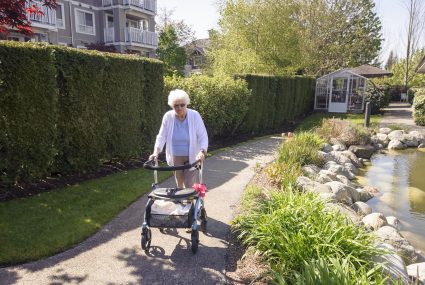Make no bones about it: Osteoporosis is fairly common. In Canada, it affects 1 in 3 women and 1 in 5 men. For seniors especially over the age of 50, Health Canada states that 1 out of 4 women and 1 out of 8 men in Canada have osteoporosis.
So what is Osteoporosis? It’s a potentially crippling disease the causes your bones to become thin and porous and very fragile from loss of tissue. It can happen as a result of hormonal changes, or if you have a deficiency of calcium or vitamin D. Your body weakens as a result and the odds of you suffering a fracture are relatively high. But sometimes it’s hard to know if you have it. The bone loss more or less happens without true symptoms along the way, so it can go undetected until there is a fracture or loss of height (associated with the spine).
We partner with BRIA Communities to offer senior residents specialized medical and treatment services if they have been diagnosed with Osteoporosis. Receiving a tailored plan for medications and supporting treatment can make a huge difference in slowing the progression.
SIGNS & SYMPTOMS
Seniors over the age of 65 are prone to the disease as bone renewal becomes even more difficult. If you fall in that age group, here are some other factors to look out for:
- Are you female?
- Family history of hip fractures
- Early menopause (before age 45)
- Low estrogen levels
- Low testosterone levels
- Fracture post-age 40
- Low Calcium intake
- Poor nutrition
- Smoking
- Low physical activity
- Excess alcohol, salt or caffeine intake
- Use of medications such as prednisone or medications for the treatment of breast or prostate cancer
- Overactive thyroid or other diseases
TIPS
Fortunately, there are a few relatively easy things you can do to minimize your risk of developing Osteoporosis in your older years:
- Exercise regularly. It builds muscle strength, prevents falls, protects the spine, slows the rate of bone loss and improves your mental state of being. Follow the guidance of a trainer or recreational assistant in the gym to establish a regular and progressive routine.
- Get plenty of Calcium. If you’re over 50, you should be taking in 1,200 mg/day.
- Get plenty of Vitamin D. if you’re over 50, you’ll need 800-2000 IU/day.
Understanding and treating osteoporosis with the right medications, exercise and vitamins can make all the difference.
If you’d like more information about osteoporosis, visit www.osteoporosis.ca.
Author Debbie Santos, RPh is the National Director of Clinical Pharmacy Services for Remedy’sRx Specialty Pharmacy. Remedy’sRx Specialty Pharmacy provides specialized services to seniors in residential settings.

Comments